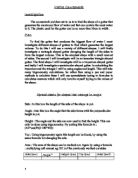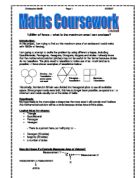When calculating the results I will not workout every area of the triangle by changing the angles by 1° at a time, as this would take much unnecessary time. Instead I will start with working out the area for every 10°. Then my results should show me the 2 points where the highest area is and then I can do every 1° between these 2 points and find the maximum area.
As I said above the 2 points that needed further calculations where between 40-50°. In the table below I have gone up by 1° at a time to get the maximum area. I predict it to be 45° as this is exactly between 40° and 50°.
As I predicted above 45° creates the largest area. An area of 112.5 cm2, this is the maximum area for the triangular shaped gutter.
Triangles and Rectangles areas linking
The maximum area created by the rectangle and triangles are identical. So I decided to investigate how doubling the shapes might create a link.
15 15
The triangle doubled forms a square, now if I double the rectangle I can see if there is a connection.
I found that the maximum area of the rectangle was identical to that of the triangle. This was because they are both half of exactly the same shape. By doubling the triangle to produce a square a 15x15 square was formed. If I were to double the rectangle a 15x15 square would also be formed:
7.5
15
7.5
15
So the triangle and the rectangle doubled formed the same shape but were divided in different ways.
Trapezium Shaped gutters
My plan is to change the angle, width and length of the trapezium. This is because the angle in a triangle that creates the maximum area is 45°, I predict that this will be the angle that creates the largest area in the trapezium. If we look at the trapezium we see that it is basically a triangle divided into 2 and putting them on either side of a rectangle. Contrarily to the triangle and the rectangles area being 112.5cm2 I predict that the trapeziums area will be 112.52
sin
cos
b
As before doing every calculation would take to long so firstly I will change the angle 10° at a time then when I have narrowed it down to less points I will change the angle 1° at a time so I can find the maximum area. When working out the area I need to consider the fact that there are 3 shapes 2 triangles and a rectangle. I will work out the area for each shape then add it together and because the trapezium is symmetrical I only need to work out the area of 1 triangle then times it by 2.
I found that the maximum area came from a trapezium that had a side length of 10cm and an angle of 30°. Though this may not be the maximum area as the maximum could be created by any angle between 21 and 39. I will now home in on these angles and find results by varying 1° at a time between 21 and 39;
After looking at the results in more detail I have noticed that the gutter with sides at 10cm and an angle of 30° creates the maximum area. It creates the same area as in the previous table, so there was no need to do another table. But it does certify the results.
The semi circle
To work out the area of the semi circle we have to use the formula (πr2)
2
The first section works out the area of a whole circle then to get the area of a semi circle we have to divide it by 2. But to work out the area we need to know the radius, which is the diameter, halved. To work out the maximum area I have to vary the radius of the semi circle. As this will give me different shaped semi circles.
With all of these having a length of 30cm all I need to find out is which length of radius creates the largest area.
Table to show sides will never equal a semi circle
The table below proves that the no matter how many sides a polygon has it will never reach the area of the circle as the circle has no sides. So as the amount of sides go up the area increases and so as the circle has no sides it has the biggest area.
I have seen that as the number of sides of a half polygon increases the area that it creates increases. I found that the difference between each does increase but the amount increased each time becomes smaller each time. No matter how many sides are on the shape there will never be a curve in the shape. A curve makes a difference to the final area created.
y x
Shape x has a straight side where as shape A has a curved. The side of shape x may be part of half polygon with many sides. Shape y is exactly the same as shape x but it has a curved side, the area of is shape is larger than that of the other shape. If shape x was part of a many sided half polygon then its interpretation with a curved side would result in a curve very much closer than the one shown here, but the difference in area would still be present even if it is only noticeable in the smallest of forms. No matter how many sides are present in a half polygon, no curve is formed. A curved line would create a larger area, as shown above. The curved side would produce the maximum area, the curved sided shape is the circle. The semicircle is the shape that produces the maximum area.
Conclusion of investigation
The aim of this investigation was to find the shape of gutter that holds the most water possible. I realised that throughout the whole investigation I would never have to calculate volume; there was no limit on the length of plastic to be used and gutters a have a continuous shape, there would be no variation in the properties of the gutter length ways.
I decided to investigate different shapes of gutter by varying length of sides and the angles at which they fall. Before I did this I decided to look at the most simple of shapes; the rectangle. I found the maximum area of this to be 112.5cm2; this was created by a rectangle wit a width of 7.5cm and a length of 15cm.
I went on to investigate shapes with more complex variations; the first was the isosceles triangle. The only variation here was in the angles at which the sides fell; the sides themselves were kept as 15cm long each, as the triangle was isosceles. I found the maximum area of this shape to be 112.5cm2; this was formed by positioning the two sides 90° apart. The maximum area here was identical to the maximum area of the rectangle, a reason for this was discovered later.
I then went on to investigate the maximum area of the trapezium. This investigation required very much more variation, in the form of both angles and lengths. I found the sides that produced the maximum area for this shape were all equal at 10cm each; the angle at which the sides fell was 120°. I noticed a quality shared by both the triangle with the maximum area and the hexagon with the maximum area; if the shapes were doubled they would produce regular polygons. The triangle produced a square and the trapezium produced a hexagon. The doubled triangle led me to notice another connection between investigated shapes. The doubled triangle was identical to the doubled rectangle, they were both 15x15cm. I remembered the fact that their areas were identical, this was because they were half the same rectangle.
The circle can be described, as having 1 side, in a true circle this is the case. A shape that has an unimaginable number of sides has the appearance of a circle but it is not. A circle must have a curved side. The polygon with sides can have millions of sides but the semi circle has the largest area as it has only 1 side. So from the start you could predict the semicircle to hold the most water as it has a curve and a curve will always create a larger area than a many sided shape even if it appears to look like a curve.
Stephen Kyle







